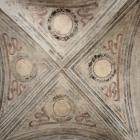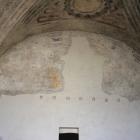The vault, divided into three bays, is decorated with tondi framed by garlands and elaborate scrolls with inscriptions in capital letters. These tondi almost certainly contained the images of the twelve apostles, as can be deduced from traces of the painted names of Peter, Andrew and John in the first bay from the south. Still legible, the scrolls bear the verses of the Apostles' Creed. The ornamental taste and style of the vault shows similarities with contemporary Lombard frescoes, akin to those of Aurelio Luini and his workshop.
Of the same period as the decoration of the vault are the illusionistic paintings at intermittent intervals along both of the longer walls, with square pilasters painted in dark colours and framed windows with faux beams.
The coat of arms and Spanish heraldry
The short walls were, instead, decorated with coats of arms, still partially visible. On the north one can make out the Spanish royal coat of arms, a great shield shape, with the collar of the Golden Fleece and surmounted by the crown of the royal family. At the centre of the emblem is the symbol of the State of Milan. The absence of the emblem of Portugal, conquered in 1580, is a terminus ante quem for the dating of the painting.
The insignia on the lower right of the opposite wall represents a shield divided into four parts, bearing the coats of arms of the castle warden and person who commissioned the work Sancho de Guevara y Padilla, the governor Antonio Guzman (1573-1580), and that of the Mendozas. All that remains of the other coat of arms is, in the top section, traces of a helmet and ornaments indicative of Padilla.










